Text
Creative Industries In Scotland
The term Creative Industries is an umbrella name for a group of different but often interconnected industries. The Scottish government has identified 16 distinct industries within this group.
advertising
architecture
visual art
crafts
fashion and textiles
design
performing arts
music
photography
film and video
computer games
radio and TV
writing and publishing
heritage
software/electronic publishing
cultural education The following is a brief look at these sectors and an example of businesses working within them
ADVERTISING
The Cambridge dictionary defines Advertising as “the activity of making products and services known about and persuading people to buy them.”
The Leith agency is a Advertising agency in Edinburgh and London. They specialise not only in Advertising but in areas such as Branding, Digital & Social Media & Strategy. Like every other sector under the Creative industries umbrella Advertising is very interconnected with many of the other sectors under the umbrella. This interconnection between sectors cannot be overstated.
ARCHITECTURE
Dictionary.com says this of Architecture ...The profession of designing buildings, open areas, communities, and other artificial constructions and environments, usually with some regard to aesthetic effect. Architecture often includes design or selection of furnishings and decorations, supervision of construction work, and the examination, restoration, or remodeling of existing buildings.
Thomas Robinson Architects are Scottish Architects based in Glasgow working in both commercial and residential projects. Conservation and sustainability have become increasingly in demand in the world of architecture. At the heart of everything they do is good design. They work closely with builders, interior and landscape designers, surveyors, civil engineers, construction managers amongst others.
VISUAL ARTS
This is quite a difficult one to define as many sites on the web include professions that are listed as a seperate sector on the gov.scot list. Drawing, painting, sculpture and printmaking are examples of the visual arts often listed alongside photography and film-making. There is a huge amount of career potential with a knowledge of and expertise in the visual arts.
On the Visual Arts Scotland website it includes many disciplines, explaining
“We are committed as a society to supporting and exhibiting a diverse range of contemporary Scottish art, in a wide variety of media - including drawing, painting, printmaking, textiles, photography, jewellery, ceramics and sculpture.”
Again we have this cross over between sectors

.
There are many career paths available with a knowledge and expertise in the visual arts.
CRAFTS
A craft is a pastime or a profession that requires particular skills and knowledge of skilled work. Usually applied to people occupied in small-scale production of goods. Another aspect of these creatives is they use their hands and hand tools to a huge extent.
The traditional term craftsman is nowadays often replaced by artisan. Examples of Crafts are Ceramics, jewellery, pottery, furniture making, woodwork, glasswork.
https://www.highlandstoneware.com
is a small ceramics company that began with making plain tableware, but soon after started to decorate the pots and it’s the hand painted aspect of their ceramics that has brought them great success
FASHION & TEXTILES
Once more it becomes apparent of the interdependence and cross-pollination of these sectors. Textiles is very much a craft as well as being a foundation to the Fashion sector.
Most commonly, fashion is defined as the prevailing style of dress or behaviour at any given time, with the strong implication that fashion is characterised by change. Textiles on the other hand can be ancient. Harris tweed for example. The cloth is woven only in the Outer Hebrides by crofters in their own homes, using methods that are centuries old.
The story of Cashmere is a great example of how Scotland has over centuries married textiles, technology and fashion to great effect
Based in Edinburgh Judy R Clark is a fashion designer known for her hand tailored womens-wear designs. Her garments comprise of Harris Tweed, Scottish lace and antique fabrics. Judy is just one of many internationaly known Scottish fashion designers.
Bodies such as Textiles Scotland showcase the vast pool of talent in Scottish Fashion and Textiles and help to bring together artists and clients.
DESIGN
Design is the process and art of planning something to be made. Design is something truly ubiquitous and outside of nature everything we see around us that has the human touch has design at it’s core.
In this article 16 types of design is a quick overview of just how fundamental to ‘everything’ design is.
Timorous Beasties is an example of a modern successful design company established 1990 in Glasgow by two textile design graduates of Glasgow School of Art. The studio is a diverse operation and has emerged as a multi-award winning, internationally acclaimed design company.
PERFORMING ARTS
There are many sub-sects that come under the headings of Drama, Dance or Music. Within those areas there is an enormous number of different roles. Production, film and education are closely tied related fields. Again there is much crossover and some would suggest that Music is very much one of the performing arts but for the sake of the Scottish Govt. list we will keep them separate, though much the same can be said for both.
The Royal Conservatoire of Scotland is one of the premier education establishments for the performing arts in the world. It is the only place in Europe where you can study all of the performing arts on the one campus.
As a small nation Scotland surely punches above it’s weight in its Performing Arts output and influence on the world stage.
MUSIC
Glasgow has been a UNESCO city of music since 2008. The UNESCO Creative Cities Network strives to promote cooperation with and among cities that have identified creativity as a strategic factor for sustainable urban development. The Scottish Music Industry Association ,with financial assistance from Creative Scotland, is an organisation tasked with representing and developing Scotland’s music industry. The SMIA delivers a wide range of services, projects and events. The association is the driving force behind such innovations as the Scottish Album of the Year (SAY) Award. Since its inauguration in 2012 the award has grown to become Scotland’s most popular and prestigious music prize.
Glasgow has a legendary music scene that stretches across the whole spectrum from contemporary and classical, to Celtic and Country. As with the performing arts Glasgow is provided a world class music education from The Royal Conservatoire of Scotland. Glasgow also boasts a plethora of venues from small bars to vast arenas with everything in-between.
PHOTOGRAPHY
Photographers create visual images for a vast range of creative, technical and documentary purposes. Usually a photographer will specailise in one area. There are many areas to choose from, advertising, corporate, editorial, fashion, fine-art, documentary to mention a few.
Photography Scotland is a consortium bringing together many of the different galleries, cultural and educational establishments in Scotland involved with developing awareness and promotion of Scottish Photography throughout Scotland and beyond.
FILM & VIDEO
With a growing Film and TV sector in Scotland, there are many new companies joining the more established players in the sector. Companies like Film Bang and Screen Scotland have been producing Scottish talent and developing funding and infrastructure for the Scottish Film and TV industry for many years. These companies and organisations work to increase the workforce and skills job opportunities, develop the sectors infrastructure and advertise Scotland as a great destination for international film and tv production companies to come and work
COMPUTER GAMES
Annually, Scottish games development companies are estimated to invest £88 million in salaries and overheads, contribute £80 million in tax revenues to HM Treasury, and make contribution of £194 million to the UK’s Gross Domestic Product.
Dundee is the epicentre of games development in Scotland with several Internationally successful developers and infrastructure . Glasgow and Edinburgh both have big players in the industry too. Most of the different companies involved in the sector are covered by The Scottish Games Network, an umbrella organisation which brings together everything relevant to the interactive entertainment sector in Scotland. Independent, the network aims to support and promote all of the cultural, creative, academic, governmental and other organisations in the video games sector in Scotland.
RADIO & TV
The Scottish Tv industry has recently been given a real boost with a collaboration between the BBC and Screen Scotland. Screen Scotland is the Film and TV wing of Creative Scotland and oversees the development of the screen industries in Scotland.This partnership promises a minimum of three drama series from Scotland, three comedy titles and three high-impact factual series each year. This comes at the same time as the launching of the new BBC Scotland channel. STV is the other big presence in Scottish TV and has been in operation since 31 August 1957
Radio, being a relatively cheaper media has an abundance of local radio stations..In Glasgow there's the local Radio Clyde station which began broadcasting as a commercial radio station in Scotland on Monday 31 December 1973. Since then many other local radio stations have appeared but, as with TV, the BBC is still the major player in Scottish radio with BBC Radio Scotland and for Gaelic listeners BBC Radio nan Gaidheal.
WRITING & PUBLISHING
Publishing Scotland is the network, trade and development body for the book publishing sector in Scotland. The charity acts as the voice and network for publishing, to develop and promote the work of companies, organisations and individuals in the industry, and to co-ordinate joint initiatives and partnership.
Canongate books is a publisher based in Edinburgh. Formed in 1973 they had their first big success with Lanark by Alasdair Gray but it wasn’t till their 2002 publication of Yann Martel’s novel The Life of Pi, that the publisher really hit the big leagues. The book became the biggest-selling Booker prize winner ever, and Canongate won Publisher of the Year.
HERITAGE
Historic Environment Scotland is Scotlands leading public body not only for the preservation of more than 300 of Scotland’s historic sites (among them many of the most famous buildings and sites in Scotland) but also for providing information to anyone wanting/needing the knowledge, skills and materials necessary to conserve, repair and maintain the built heritage.
They also look after a vast collection of photographs and other artefacts. Documenting and researching the ever-growing collection in their care. Alongside this is their research into climate change and how methods of preservation will have to adapt to meet the new weather challenges of the 21st century.
SOFTWARE/ELECTRONIC PUBLISHING
As with the Writing & Publishing above, while researching this sector the overwhelming majority of search results turn up Publishing Scotland. The pages in question are about a now-defunct fund that supported Scottish-based book publishers in bringing their books to a new digital audience. Also a huge amount of adverts for desktop Publishing.
-------------------------------------
Following the election of the first Blair government in 1997 and using as a starting point the findings of the study entitled ‘Creative Nation’ produced by the Australian Government in 1994, the Department of Culture, Media and Sports (DCMS) produced a document that attempted to define and measure the Creative Industries in the UK. Creative Industries was at this time only beginning to be something with a name.
The DCMS regarded the creative industries as: ‘those activities which have their origin in individual creativity, skill and talent and which have a potential for wealth and job creation through the generation and exploitation of intellectual property’
In this document they identified 13 sectors. Though slightly amended over time in the UK (this ‘Creative Industries’ model has been imported to many parts of the globe since and evolved to suit national cultural circumstances, eg. sectors such as gastronomy) the original 13 sectors have changed very little.
Advertising, Architecture, Arts, Crafts, Design, Fashion, Software & Computer Services & (Games), Music, Publishing, Film & Video, TV & Radio, Performing Arts
in 2002 London’s then mayor, Ken Livingstone, established a Commission on the creative industries, to assess their value and potential contribution to the city’s economy. DCMS continued their research into the creative industries and in 2008 published the report Creative Britain and Digital Britain the following year. These reports brought to light evidence of the extent to which the digital and creative sectors were merging due to technological change.
The last figures available for the value of the Creative Industries to the UK economy are for 2017. For the first time the Creative Industries contributed over £100 Billion to the economy at £ 101.5 billion and since 2010 have been growing at twice the rate of the economy as a whole. In part this growth is due to the success of the computer gaming industry which contributed more than £5 billion alone.
The identifying of the Creative Industries in 1998 and subsequent development of strategy for providing investment and nurturing growth has been an evolving economic and cultural success story in the Uk. The advances in digital technologies married with the Creative Industries have had a direct impact in the vitality and growth of many locations throughout Scotland and the wider region.
Dundee is a great example of the regenerative potential of the Creative Industries and digital technologies not only in the economic life of a town or city but also culturally and socially. With world class education infrastructure in games development and a large number of successful games companies, from fledgling start-ups to big international players, the city has come a tempting destination for many in the gaming industry, both home-grown talent and those from further afield. Along with that financial success and wealth of creativity comes a cultural boost. In the case of Dundee the most visible development to the city’s Cultural voice was seen and heard with the opening of Scotland’s first design museum, the V&A Dundee. This success in turn provides resources for more jobs, training and infrastructure not just directly in the Creative industries but in the wider economy.
Examples of this can be seen all over the UK. In London the district of Shoreditch was the early shining example of the power of regeneration thru directing creatives to set up shop in an area, rather neglected but with plenty of cheap warehousing. The transformation, over time was quite astonishing and for a great many there were handsome rewards for their success. Along with the many stories of job and wealth creation there are however the victims of this success. Life long residents slowly (or not so slowly) priced out of their area. Whole neighbourhoods evicted by the success of gentrification without, it seems, too much thought given to the lives, traditions and ‘culture’ of these locals.
Refinement of the Creative Industries concept has continued and now is more often referred to as the Creative Economy. It was found that there were more than 50% of creative jobs in the ‘Non-Creative’ industries than in the ‘Creative’
As for myself and the direction I wish to follow I have no definitive answer. As the course unfolds and I discover the full range of potential employment and experience the realities in the workplace I expect I will begin to focus on a particular area. At this point in time I know what interests me most and what I would like, in general, to be doing. I’m attracted to portraiture and people, to storytelling and to travel. Over the next years of study and experience it will be seeing how these interests come together.
0 notes
Text
A Sense Of
This brief comes as a competition promoted by Ilford. The theme is extremely open. The guidelines are basically photographs are to be taken with Ilford B&W film and printed on Ilford paper. Using the theme A sense of.. you have to produce four images that evoke the word you have chosen. I have chosen to use the theme of Home.
A SENSE OF HOME
The idea for this project comes from my experiences of living in emergency social housing for the last 6 months. I’ve come to have an insight into some of the difficulties and deprivations faced by the people I've met and many more living at the edges of society. The challenges of trying to build a stable life with no foundation. There are so many reasons why people might find themselves homeless. The stresses of living “close to the edge” ,in poverty. Mental, physical and emotional health problems overwhelming the ability to cope.
My 'Guest House’ is at the top of a steep hill. At the bottom there is a row of shops I pass every morning. And every morning there is a young woman sat, begging,. I wondered what her story was, what circumstances could lead to someone so young to already be facing such a struggle in life.
I began to stop to talk to the young woman. Her name is Jessica. Over the last six months we got to know each other and a trust developed through knowing each others story. That I was living in a hostel she had also lived in some months before allowed her to feel some sense of me ‘knowing the score’, that there was no-one being judged.
Since I've been living in emergency social housing I’ve had the growing notion to tell the story, not of me personally but of this desperate world I saw around me. In Jessica I saw the personification of this world of the struggling and wounded and largely invisible. We talked about this project and she agreed to be part of it.
It’s not a four photo story or a one person story. It’s the beginning of finding a visual voice for something more. I like the idea of a project that will develop and last for the duration of my college life and beyond.
On discussing this project with my tutor I was recommended to check out the work of photographer Jim Mortram.
Jim has for the last 10 years been developing a project ‘Small Town Inertia’ that follows the lives of several people in the small town of Dereham in Norfolk where he lives, working as a full time carer for his mother. The work focuses on themes of disadvantage and social exclusion. The elements of trust and building relationships with the people he photographs are paramount to the work.
3 notes
·
View notes
Text
We’re all off to the movies.
In this brief we will be learning the basics of making a short film. The necessary technical knowledge..lighting, movement, focusing, storytelling techniques. What equipment to use, where and when, and how to combine everything into a whole greater than the sum of the parts.
Our short film will be on the subject of The Artisan. Highly skilled craftsmen and women who, using tools and their hands produce unique quality products in contrast to mechanised mass-production.
To begin with we will look at some short films or film clips to study some techniques ‘in action’
https://vimeo.com/aesopskincare/the-guild-of-artisans
https://youtu.be/csOXRW9dvrQ
https://youtu.be/gjQv3gDeSKw
https://youtu.be/jeJVNQ4ngfo
https://youtu.be/rMPkUuMq024
1 note
·
View note
Text
ILLUSION.
COMPOSITING
This is a project I've been viewing with horror and delight in equal measure. It goes completely in the face of everything i have done with photography up till now. My style has always been see something that catches my eye and try and capture what sucked me in, whether that's the light, colour, shape, a fantastic face or style, it has always been of the moment. That moment then goes to Lightroom where it will get a very minor tweak here and there. Job done
With this project all that changes completely. In all sorts of ways.
CONCEPT...There has to be a concept, an idea behind the image. Once a concept is developed the background image has to be sought out, hunted down and shot. It maybe that you go out shooting and happen on a scene that suggests something you could develop in the studio. That would be all well and good as a habit to get into, shooting potential backgrounds, but when starting a project like this for the first time there is a limited amount of time for suggestive backgrounds to appear. With this deadline beginning to loom and constructive action needing to be taken soon panic is setting in that nothing has presented itself to me as yet so some research and hard graft are necessary.
Getting the concept is only the beginning of the changes. Having now done some studio work I'm feeling a bit more relaxed about when it comes to that part of the project but the big one is PHOTOSHOP. Unfamiliar as I am this is where there will be a big and much needed learning curve. I’ve never felt the need to get into photoshop, the Develop panel in Lightroom doing 99% of everything I thought I needed. But the point has been passed already when I think I could have done some task better in photoshop but just didn't because of ‘The FEAR’!!! This has to be overcome and apparently the time is now.
So, for me, a challenging brief but one I can expect to learn an awful lot from. Now it begins with some research about Compositing, what is it, who does it, how do they do it, why do they do it and some of the images they create..
First is some images and an assessment of how they might have been achieved

This is an image by the super talented photographer Erik Johansson. I love it. I love the humour, the beautiful, muted colour tones and the apparent simplicity. There’s doesn't look to be too much going other than the trick of elevating the dog. Everything else seems normal. And that’s exactly the point..
The direction of the light is strong, coming into the image from the left at about a 45 degree angle in front of the person and dog, leaving long, strong shadows behind the subjects, giving a strong sense of the source and strength of the light in the scene, The light spot reflected on the balloons reinforces this.
It seems like the image could be made from several different photos...
The background, the woman, the dog, the balloons, even the dog leash. Maybe the woman was in the background picture? And what about those shadows?
My panic is beginning about grow. Oh, how little I know about photoshop!
0 notes
Text
Catch Me If You Can
SPORTING EVENT..RESEARCH
Adults running about a field chasing a ball, or running very fast, jumping over things of varying heights, throwing things, catching things, hitting various things with a stick. In a small confined space punching each other. Or swimming up and down and up and down. Sitting on the back of a running horse.The list is almost endless. This world of needless physical exercise is called Sport...and is full of drama and emotion, both for those who do it and those who watch it...apparently!!
In this project I will show a selection of these people, both participants and spectators in the “moment”, engaged in their chosen activity.
Using a variety of photographic techniques I will attempt to make a visually appealing assortment of images....So here goes, first things first...
How to do it!
With every sport there will be a differing set of challenges facing the photographer.. The size of the area, is it the size of a boxing ring (for two people punching each other) or the size of a football field (for 22 people kicking a ball) or even bigger.
How close can you get to the action
How many people are taking part..just two or a whole lot.
Is it indoors or outdoors
Natural lighting or specially constructed lighting specifically for the sport in question.
All of these different scenarios will dictate what kind of equipment the photographer will need and the way the camera should be set up.
So before you can really start it’s helpful to know what sport you will be photographing. Sometimes you will just have to learn quick and work it out on the job.
SOUND ADVICE FROM PEOPLE WHO DO THIS FOR A LIVING
Having just read a google’s worth of ‘Top ten essentials for sports photography’ and for the basics there seems to be a general consensus with the preferred functions on the camera. The main factor for professionals is continuous burst speed with some of the present crop of top the range sports oriented DSLR’s shooting 14fps or more. With the speed of the action things are changing in those fractions of a second and having the ability to be able to follow those changes so closely is a highly sought after function. With most prosumer cameras these days the ISO capabilities are becoming increasingly impressive with ISO32000 in the native range of the camera becoming the norm and with that also stunning reductions in the noise at these high ISO levels. These ISO levels really assist in reaching the shutter speeds used in a lot for freezing this high speed action. Starting at 500th of a second and going up. 2000th of a second is not unusual. Along with high ISO the next thing to assist in these high shutter speeds is the next topic of general agreement....
Lenses.....lenses should be fast, as fast as can be. The aperture of a good lens for sport if using a zoom is f2.8. It’s not uncommon for a professional sports photographer to have 3 camera bodies.The most common, and most versatile, setup for most professional sports photographers is to start with the trio of 16-35mm ƒ/2.8, 24-70mm ƒ/2.8 and 70-200mm ƒ/2.8 lenses. These three options provide all the coverage needed to shoot everything from wide-angle shots of a packed stadium through any action happening up to midway down most sporting venues. Though these lenses are not cheap, when it starts to get to the bigger fast primes that will allow you to see the action close up at the other side of a stadium or football field they can cost the same as a nice family car. For those beginning their sports photography there are some great lenses that along with the high ISO capabilities just talked about it will do a great job without having to be so wide open. A 70-300mm f4-5.6 or even 150-600mm f5-6.3 will do a great job of covering that far away action.
Another piece of advice where there is general agreement is in positioning. Get to the venue early and have a good look at all the potential spots and make sure you’re good to go with your settings before the action starts....But don’t stay in the one place and don’t just focus on the action. In the audience there is as much drama as on the field of play, or after some high point of action...the reaction. There are winners and losers and both have equal visual weight and potential to produce the image that encapsulates the moment and the whole event.
Another is ..You are a photographer first and foremost, the subject is sport but the intent is a striking image with light and shadow, composition, balance, colour, story all fundamentals.
WHERE TO SHOOT.
If you are not inclined to sports then it is apparently very easy to block it out of your daily experience and be blissfully unaware but as it happens, open your eyes to sports and its everywhere, EVERYWHERE!
Local newspaper for local events, google to check out what's on in your local area and further afield. Amateur or professional. Check out sporting arenas, sports and athletic clubs, football stadiums. If there is a particular sport you are interested in you can refine your search. If you’re not to bothered which sport to start with then prepare a general polite letter asking whether you can come and take photos. Send it out to as many events as you can find. Cast the net far and wide and the chances are you would be spoiled for choice.
Here we are about two months later...It’s taken a while to get access to sports, longer than I had at first thought but now I have I’m hoping for a variety of sports to shoot. I made contact with Glasgow University Sports Association which is the umbrella organisation for more than 40 sports clubs at the University. The Association has recently been actively seeking Photographers to shoot all the club games.
Seeing as time was running out on the brief I took the first possible opportunity to shoot. It was an inter-university fencing tournament Men and Women. Men against Bath University..cant remember the women's opposition University.
As soon as I was confirmed to shoot I started to watch some YouTube videos on the rules of the sport, the moves and the scoring.
It was quite a challenging shoot. It was in a large, bright gym hall. A long (14m) rubber mat with the essential markings for the game was rolled out and taped to the floor about two meters from the wall. Too close to the wall to be able to shoot from the wall side, just too near the swishing blades. The problem was that this wall was one vast mirror reflecting not just those fencing but the spectators and myself. This made for a challenge to minimise the distraction of everything else in the reflection.
In fencing the action is fast. In Olympic sports second fastest behind shooting I was told by one competitor. I was set to f4 and to get the quick exposures I needed to freeze the action (1/1000th/s) the ISO was pushed up to 6400.
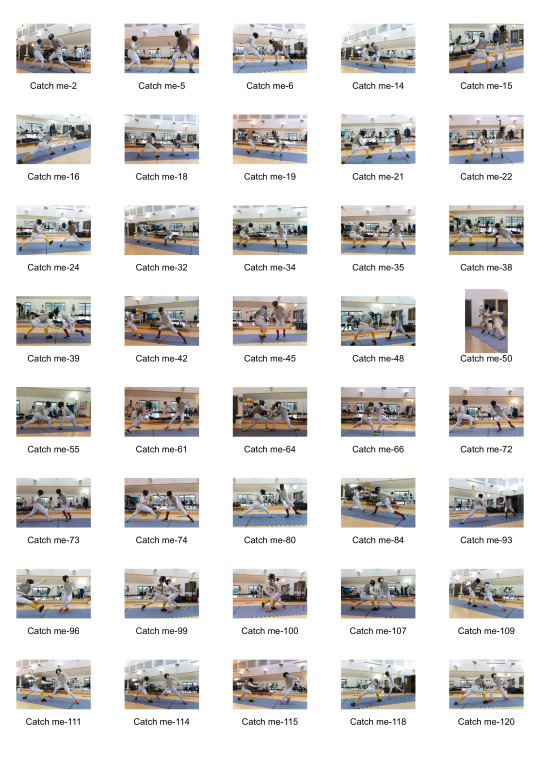

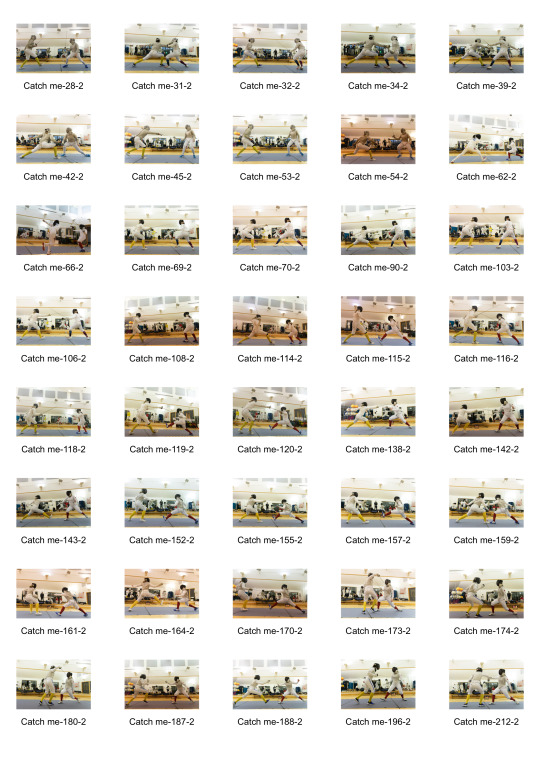
Saturday 8th March. 9am-5pm. Glasgow Caledonia University. Today I shot a trampolining tournament with all Scottish Universities competing. It was in a large high gym hall with what looks like big halogen spotlights. There’s about 200 people in the hall, mostly either competing, judging or organising. Its not open to the public. After some shots my exposure settings settle at 1/320th f4 ISO6400. I didn’t want to push the ISO much higher and had to make a compromise with shutter speed. In many of the images there is movement in the feet of the athletes. I made a decision based on the aesthetics. I liked this slight movement in many of the images, a suggestion of movement. There was no high vantage point so I made do with standing on a chair. It gave me enough of a height advantage to clear the images of the people walking about in the hall. They really didn’t add to any of the images. I did include one or two all the same that didn't distract from the action.
I’m much happier with this set of images than with the fencing from the previous sports shoot. With that shoot the large wall mirror behind the 🤺 that ran the length of the hall was so distracting..reflecting everything in the hall..the fencers, the other competitors...and me! It made it almost impossible to get simple, strong images being much too busy.
This time around it was a far easier shoot to get a more aesthetically pleasing result. Often against a background of a large plain wall with few distractions and with lighting that also had a dramatic quality.
Overall i’m extremely pleased with the results. There are some possible portfolio contenders.
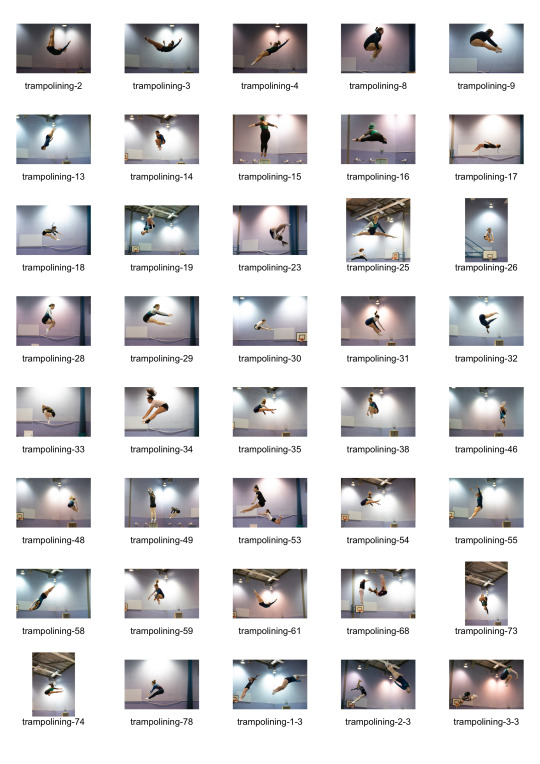
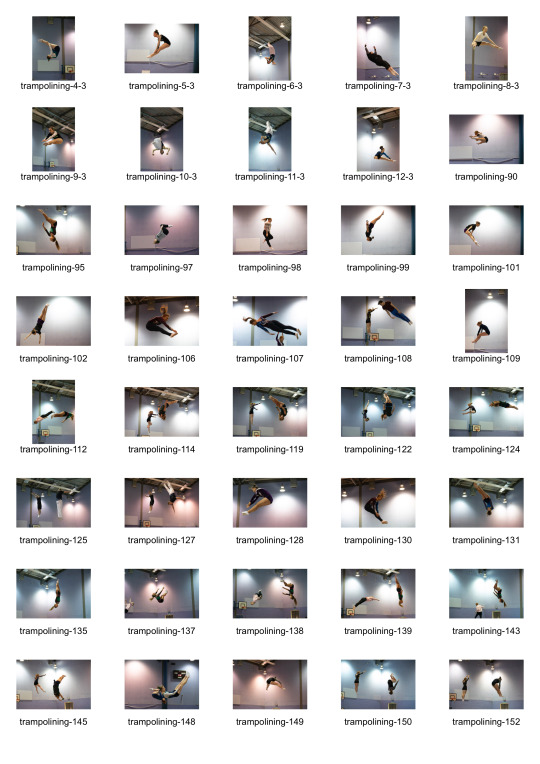

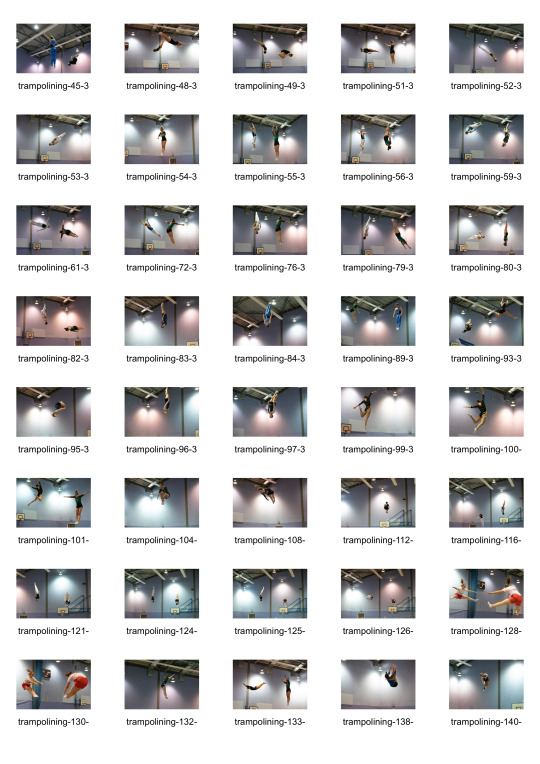
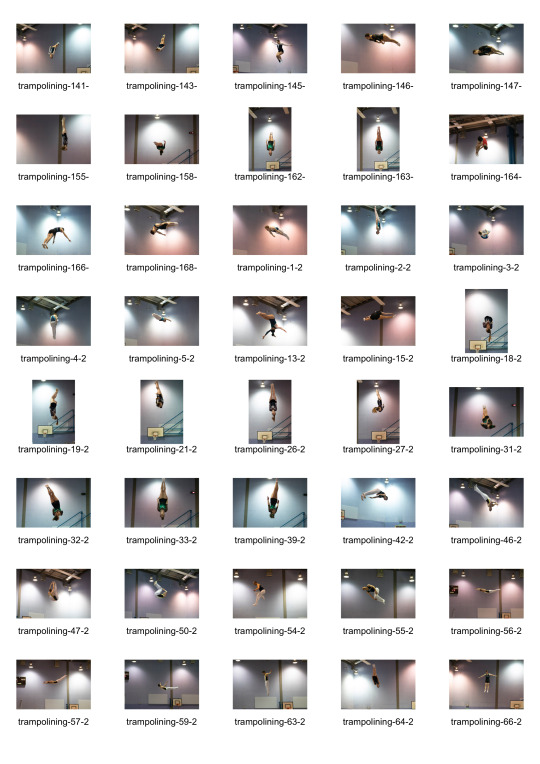

Third and final set of photos for the brief. This time it was outdoors, in the evening, cold and pouring of rain. Bellahouston outdoors ski and snowboarding center. Again it was an inter universities event sponsored by Glasgow Taxis.
It was a difficult shoot. Unevenly lit, there were pools of light and areas of dark. The area was large and the athletes were going at speed. This demanded several skills. The most challenging was to get a handle of the AF system on my new camera. Sports are generally demanding on AF and this was no different. Using 2 camera bodies..Canon 5dmk3 and 5dmk4 with a 24-105 f4 on one and a 70-300 f4.5-5.6 on the other.
The action started just as it was beginning to darken so the exposure needed to be adjusted over the first half hour or so until well after sunset and the only light was artificial. Because of the layout of the slope and the nature of the contest there wasn’t much variety of movement and routes taken down the course. At the end of the ski tournament there was some snowboarding a ski freestyle which promised a lot more exciting images but unfortunately the heavens opened as this began and the rain poured down. Having been out in the bitter cold with no gloves for 3 hours (lesson learned) and the lenses not being weather sealed to a Scottish downpour level I decided to retreat.
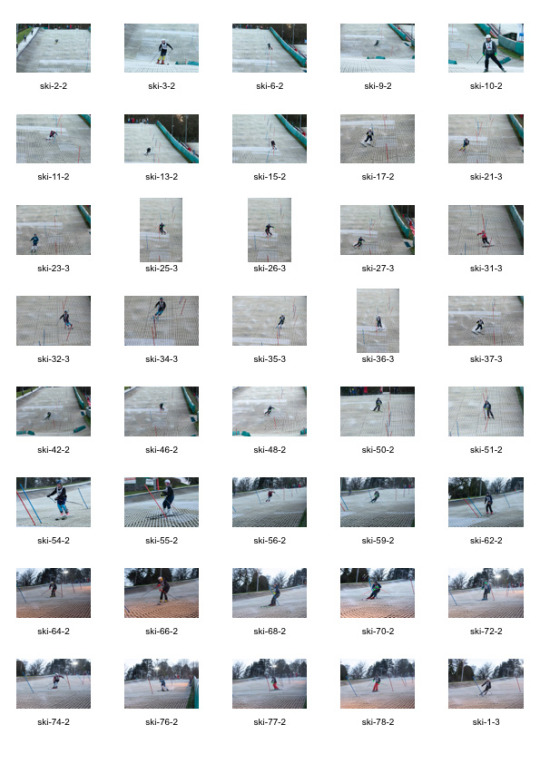
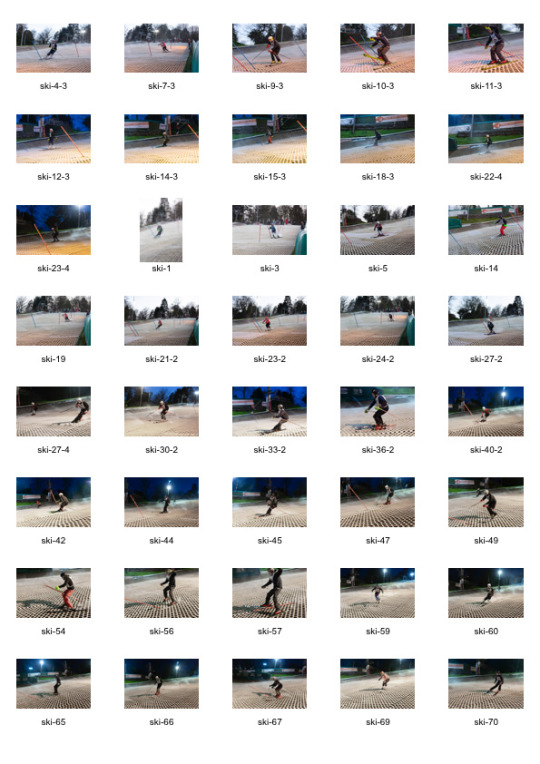
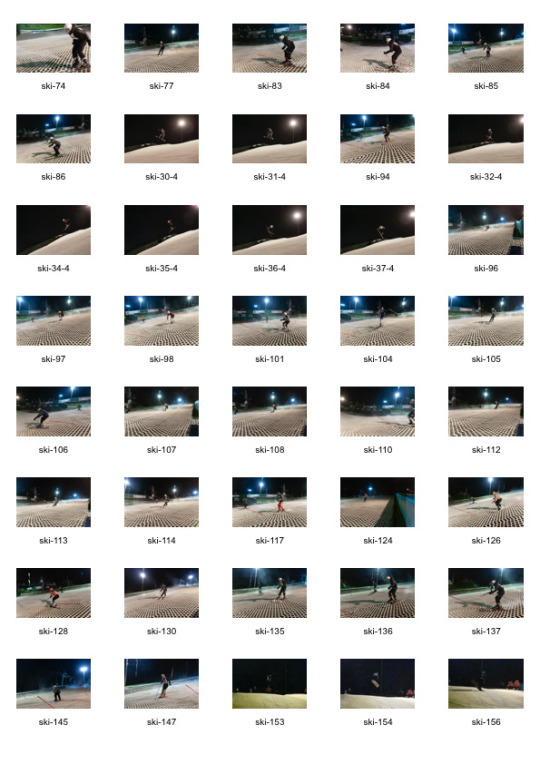
This has been a thoroughly enjoyable brief, much against expectation. There have been challenges at every event that I would like to think I have dealt with and overcome to produce many images I'm very happy with. I have become more aware of the reasons why sports photographers need that extra quality in their gear. Proper weather sealing and fast f2.8 lenses are just near essential for any professionals working in this area. Knowing something of the sport you are shooting helps. Getting to the venue early and checking it out, finding where the good light is, also helps enormously. And moving about to get different points of view.
There have been many photos taken for this brief-in total probably near 5000. Of those I have whittled it down to 500 or so. The final challenge is to choose the final 6 for printing and submission.
Of the 3 sports I shot for this brief the trampolining was by far the most enjoyable and i’d say successful. Producing the most images I was happy with. Well lit venue with not too many visual distractions and the sport itself was so conducive to aesthetic interpretation.
The time spent has been quite considerable for this brief with two full days and one half day of shooting and then because of the huge number of shots another 3 full days of choosing, deleting and optimising the images. That said, there has in fact been very little optimisation in post. In all three sessions I have used lens correction, in some a tweak of white balance. And in very few a touch more, lightening shadows or reducing highlights but very little else.
On revising everything I see that after 5000 photos I've forgotten one of the requests of the brief..to have a panning shot!!! This is bad news. Time is very short and to shoot some more sports is a days worth of work. First getting some sports to shoot, shooting and then picking and processing. For not reading the brief properly I’ve lost a day at a very crucial point in time where I need every second. One big lesson learned. Less than 2 weeks to go.
SOURCES .. So Far
https://artsandculture.google.com/exhibit/the-art-of-sports-photography-from-prints-to-images-1835-2017-the-olympic-museum/MwKStrCJtolhKg?hl=en
https://www.amateurphotographer.co.uk/technique/how-to-shoot-action-and-sports-photography-625
https://photographylife.com/getting-started-with-sports-photography
https://improvephotography.com/52236/15-tips-get-started-sports-photography/
https://petapixel.com/2018/12/06/6-simple-tips-for-getting-started-in-sports-photography/
https://expertphotography.com/complete-guide-sports-photography-87-tips/
2 notes
·
View notes
Text
Cheap pt2..The Correction
If at first you don’t succeed..
Following on from the portfolio review last week I have been asked to shoot another photo for the #cheap project...this time following the brief!!
If I'm perfectly honest i did expect this would be the case. Somewhere between the first and second shooting session I had mislaid my objects (coloured crayons and a sparkling disco deer)

and on the day of the 2nd shooting accepted Julie’s kind offer of a flower head and set about trying to get some dramatic lighting.


Nice though the flower was and there were some really nice photos of the flower...that’s what it is....a nice photo of a flower!! So....
Finally I have decided on what was actually my very first idea, the idea that popped into my head when the brief was announced...a corkscrew/bottle-opener. There is definitely something about that very first flash of an idea..before research or study of any kind, that seed of an idea.as much as research is such an essential aspect of developing these briefs, if you have an idea the research can help give you breadth and depth. Ways of executing the idea, different lighting, backgrounds, techniques, lens choice.
After a few test shots i’have realised that what I need is the use of a Macro lens.

There are so many amazing shapes within the object and given the right lighting the reflections off the polished metal could really add something special but like I mentioned, I need a Macro lens..I really want to get up close and get abstract
At this point I have to confess to being totally undone by this brief for a number of reasons. I had set out to borrow a macro lens at the beginning of the Christmas break from the college store and was advised by one of the knowing technicians that the best macro lens would be the Canon 65mm macro which has up to 5x magnification. Not sticking to my initial choice I deferred to the suggestion of the technician. The lens turned out to be wholly unsuitable and scuppered that plan. The major sticking point not just with this project but with almost everything increasingly over the past two months (I'm not sure this is the place for this but I reckon it’s relevant) has been a chronic inner ear infection- Labyrinthitis which has caused total mayhem to my cognitive abilities and also made looking at a computer screen almost impossible. After almost two months I am beginning to feel slightly less dizzy and nauseous but it seems the previous infection is now being replaced by chronic fatigue...medical tests are being done.
As much as I desperately wanted to finish this brief...1photo, just one damn photo, I have as yet not been able to do so. I had been getting extremely anxious about the situation but over the last couple of weeks I’ve just had to tell myself to relax.
I can only say I hope to put this project to bed in the next couple of weeks.
I still haven't put it to bed and its been months. The change in tutors has been a bit of a problem. I’m not sure who to ask. I have made a series of photos and will have to ask someone if they fulfil the brief.
I had found the most perfectly crushed, squashed coca-cola can. It was just absolutely beautiful. I set up a light board with a soft box on either side and a white piece of card at one end to have as much light as possible. I had a circular polarising filter on the lens to help minimise unwanted reflection. The camera was mounted on a tripod and a remote trigger was used. Canon 5dmk4 and Sigma 35mm Art lens. F8-ISO 50 and using shutter speed to control exposure.






1 note
·
View note
Text
Cheap Research
Flowers. This research was done for shooting flowers..obviously. As that wasn't acceptable I will be doing more relevant research for the brief.
https://cityofglacolac-my.sharepoint.com/:w:/g/personal/30340480_cityofglacol_ac_uk/Eey5B3AZtF9DsNOYqd0fPqwBE2gFUa0hbFc6ljTiOhEMTw?e=afRuEM
0 notes
Text
Who Am I
Evaluation
Who Am I, a project that had me , for the first time, turning the camera on myself. I was immediately ‘Up For It’. I had never given any thought to a self portrait, I had never even taken a selfie of myself.
I found the biggest challenge and the biggest pleasure was distilling myself, my character and circumstances into three images. Of telling a story that would give the viewer an insight into my world. A large part of the project was deciding how much I was willing to strip down the facade and reveal something of my hidden self and I think I achieved a balance I'm happy with though as the beginning of an ongoing project I think I would get braver and begin to challenge myself increasingly to reveal more, not just to the viewer but to myself as well.
To be honest there weren't any new techniques learned as far as camera or post processing, all photos were fairly uncomplicated and with very minimal processing. With all the photographs time was taken to get as perfect exposure as possible to minimise the need for much post processing or having to spend time not just using photoshop but having to learn how to use Photoshop from scratch. The thought of having to get out books and start studying photoshop from the very beginning with everything else going on felt rather overwhelming. What was new was the self inquiry with a purpose, of the introspection and questioning, of the trying to make an honest representation of my thoughts and feelings.
I must admit I only really sat down and researched other photographers work after the fact and possibly feel glad I did for this first attempt. I think there is a simple honesty to the photographs I took and had I studied the work of others too much before this first attempt I may have been a bit too contrived and tried to be too clever clever. For sure there is a huge amount to be learned on the subject and to see from the vast body of work of the genre from Robert Cornelius to Claude Cahun to Mapplethorpe and Cindy Sherman.
The techniques I do need to learn (I grabbed Paula’s photoshop knowledge to assemble the triptych) are with photoshop..having until this course never used photoshop and only minimally with Lightroom.
I fully enjoyed the development of the project, and although I had never done a self portrait before I felt in my comfort zone..not that I don't want to be challenged, quite the contrary but having not studied for a long time, a long, long time..it was great to be able to ease into the course. The guidance from tutors was minimal during the project but the wise words I did receive were absolutely spot on, from having every image in the same orientation to the choice to lens.
What I'm most pleased with is that I think I achieved what I set out to do. The feedback was very rewarding, of people saying that they got a deeper insight into who I am. I think I did give more than a surface impression, that there is an honesty in the work. I believe I fulfilled the brief.
What I did find, unsurprisingly and rather obviously is just how important light was to the project so that I didn't need to do more post processing or use additional lighting. By that I mean how important it was to shoot at the right time of day and the right kind of weather. Indoors and out it was available natural light was used so I learned to observe the light in the places I was shooting throughout the day to know exactly what time gave the light I was looking for
2 notes
·
View notes
Text
Who Am I
Research
Starting with an article in My Modern Met I discovered the photographer Claude Cahun. A photographer, writer and sculptor Cahun seems to have been an artist well beyond their time. Working between the 1st and 2nd world wars s/he fought against notions of gender, taking the neutral gender name of Claude. During the 1920s Cahun produced an astonishing number of self-portraits in various guises such as aviator, dandy, doll, body builder, vamp and vampire, angel, and Japanese ..more than half a century before Cindy Sherman amongst others would continue to ask questions of identity. S/he embraced androgyny and their work played with these notions of gender and identity.. As s/he explained in the autobiography Disavowals
“Masculine? Feminine? It depends on the situation. Neuter is the only gender that always suits me.
She worked closely with The Surrealists and at an exhibition curated by David Bowie in NYC in 2007 he said..
You could call her transgressive or you could call her a cross dressing Man Ray with surrealist tendencies. I find this work really quite mad, in the nicest way. Outside of France and now the UK she has not had the kind of recognition that, as a founding follower, friend and worker of the original surrealist movement, she surely deserves.".

It’s impossible to talk about modern self-portrait photography without talking about Cindy Sherman whose work consists exclusively of photographic self-portraits, depicting herself in many different contexts and as various imagined characters. Sherman has captured herself in a range of guises and personas which are at turns amusing and disturbing, distasteful and affecting. To create her photographs, she assumes multiple roles of photographer, model, makeup artist, hairdresser, stylist, and wardrobe mistress. With an arsenal of wigs, costumes, makeup, prosthetics, and props, Sherman has deftly altered her physique and surroundings to create a myriad of intriguing tableaus and characters, from screen siren to clown to aging socialite.
Although Sherman is the only person involved in the making of her photographs she herself doesn’t consider them self-portraits.
“Everyone thinks these are self-portraits but they aren't meant to be. I just use myself as a model because I know I can push myself to extremes, make each shot as ugly or goofy or silly as possible.”
“I feel I'm anonymous in my work. When I look at the pictures, I never see myself; they aren't self-portraits. Sometimes I disappear.”
“I’m trying to make other people recognize something of themselves rather than me.”



sources MoMA.org
1 note
·
View note
Link
Five photographs with clean white backgrounds for Clean white research
1 note
·
View note
